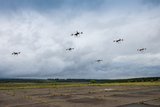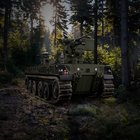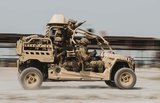X-47B UCAS successfully operated by CDU
Northrop Grumman has taken a first critical step toward demonstrating that the X-47B Unmanned Combat Air System (UCAS) demonstrator can be manoeuvred safely and wirelessly on the crowded deck of an aircraft carrier. The company carried out a shore-based trial in cooperation with the US Navy in early November which saw the aircraft successfully controlled by a new wireless, handheld device called a Control Display Unit (CDU).
Developed by Northrop Grumman, prime contractor for the US Navy’s UCAS Carrier Demonstration (UCAS-D) programme, the CDU device will allow deck operators to manoeuvre the X-47B by remote control on a carrier deck.
During the trial, the team demonstrated the CDU's ability to control the X-47B's engine thrust; to roll the aircraft forward, brake and stop; to use its nose wheel steering to execute tight, precision turns; and to manoeuvre the aircraft efficiently into a catapult or out of the landing area following a mock carrier landing.
According to the company, in practice, a deck operator will work in tandem with the flight deck director to move the X-47B via the CDU to a designated flight deck location. Standing in front of the aircraft, the director will use traditional hand signals to indicate how, when and where the aircraft should move, the same way he would communicate with a pilot in a manned aircraft. The deck operator will stand behind the director and use the CDU to duplicate the director's instructions as digital commands to the aircraft.
Daryl Martis, Northrop Grumman's UCAS-D test director, said: ‘The CDU is fundamental to integrating the X-47B seamlessly into carrier deck operations. It will allow us to move the aircraft quickly and precisely into the catapult for launch, or out of the landing area following recovery. Both of these activities are essential to maintaining the rhythm of the flight deck.
‘Instead of towing the aircraft out to the flight line, we can now start the X-47B outside its hangar, then use the CDU to taxi it out to the runway, or into a catapult for launch. Use of the CDU is the most time-efficient way to move the X-47B into the catapult or disengage it from the arresting gear after landing.’
The UCAS-D programme plans to conduct its first shore-based catapults of X-47B aircraft later this month. That testing will be followed by hoisting an X-47B aboard an aircraft carrier, and using it to validate the performance of the CDU in an actual carrier environment. In 2013, the programme plans to demonstrate the ability of an X-47B to safely operate from a navy aircraft carrier, including launch, recovery, and air traffic control operations.
More from Uncrewed Vehicles
-
![Ready for the race: Air separation drone swarms vs. air defence systems]()
Ready for the race: Air separation drone swarms vs. air defence systems
As the dynamics of aerial combat rapidly evolve, Chinese scientists have engineered a sophisticated air separation drone model that can fragment into up to six drones, each capable of executing distinct battlefield roles and challenging the efficacy of current anti-drone defences such as the UK’s Dragonfire laser system.
-
![Israel’s MALE UAVs ‘must adapt’ to Iranian-made air defences]()
Israel’s MALE UAVs ‘must adapt’ to Iranian-made air defences
Advancements in air defence technologies have begun to reshape aerial combat dynamics in the Middle East, as illustrated by recent events involving the Israeli Air Force and Hezbollah.
-
![Hundreds more UAS sent to Ukraine forces with thousands more on the way]()
Hundreds more UAS sent to Ukraine forces with thousands more on the way
Both sides of the Russia-Ukraine war have been using UAS for effective low-cost attacks, as well as impactful web and social media footage. Thousands more have now been committed to Ukrainian forces.
-
![AI and software companies selected for US Army Robotic Combat Vehicle subsystems]()
AI and software companies selected for US Army Robotic Combat Vehicle subsystems
The US Army has intentions to develop light, medium and heavy variants of the Robotic Combat Vehicle (RCV) as part of the branche’s Next Generation Combat Vehicle family.
-
![DroneShield to improve software of DroneSentry-X C-UAS system under new contract]()
DroneShield to improve software of DroneSentry-X C-UAS system under new contract
DroneSentry-X, a cross-vehicle compatible, automated 360° C-UAS detect and defeat device, can offer 360° awareness and protection using integrated sensors. According to its manufacturer, it is suitable for mobile operations, on-site surveillance and on-the-move missions.
-
![Ukraine takes delivery of new indigenous C-UAS systems]()
Ukraine takes delivery of new indigenous C-UAS systems
Funded by the country’s former president, the new C-UAS systems will be sent to the frontline where they have already been tested against Russian invading forces.


























